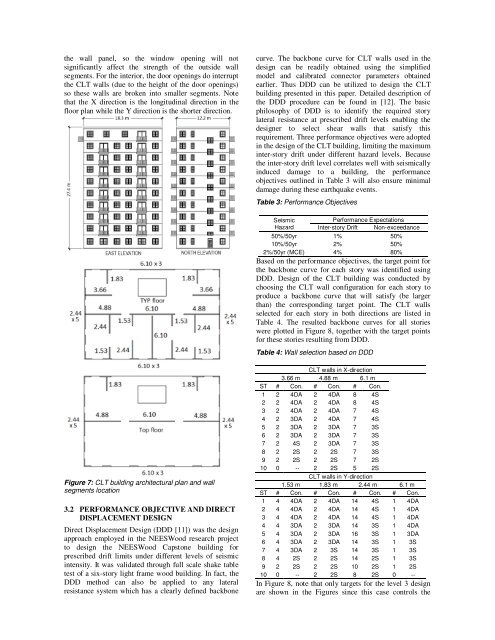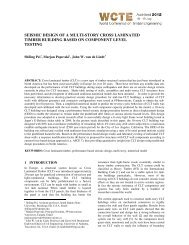o_19kg9ii0eqvma9v466p3d1ubia.pdf
You also want an ePaper? Increase the reach of your titles
YUMPU automatically turns print PDFs into web optimized ePapers that Google loves.
the wall panel, so the window opening will not<br />
significantly affect the strength of the outside wall<br />
segments. For the interior, the door openings do interrupt<br />
the CLT walls (due to the height of the door openings)<br />
so these walls are broken into smaller segments. Note<br />
that the X direction is the longitudinal direction in the<br />
floor plan while the Y direction is the shorter direction.<br />
curve. The backbone curve for CLT walls used in the<br />
design can be readily obtained using the simplified<br />
model and calibrated connector parameters obtained<br />
earlier. Thus DDD can be utilized to design the CLT<br />
building presented in this paper. Detailed description of<br />
the DDD procedure can be found in [12]. The basic<br />
philosophy of DDD is to identify the required story<br />
lateral resistance at prescribed drift levels enabling the<br />
designer to select shear walls that satisfy this<br />
requirement. Three performance objectives were adopted<br />
in the design of the CLT building, limiting the maximum<br />
inter-story drift under different hazard levels. Because<br />
the inter-story drift level correlates well with seismically<br />
induced damage to a building, the performance<br />
objectives outlined in Table 3 will also ensure minimal<br />
damage during these earthquake events.<br />
Table 3: Performance Objectives<br />
Seismic<br />
Hazard<br />
Performance Expectations<br />
Inter-story Drift<br />
Limit<br />
Non-exceedance<br />
Probability<br />
50%/50yr 1% 50%<br />
10%/50yr 2% 50%<br />
2%/50yr (MCE) 4% 80%<br />
Based on the performance objectives, the target point for<br />
the backbone curve for each story was identified using<br />
DDD. Design of the CLT building was conducted by<br />
choosing the CLT wall configuration for each story to<br />
produce a backbone curve that will satisfy (be larger<br />
than) the corresponding target point. The CLT walls<br />
selected for each story in both directions are listed in<br />
Table 4. The resulted backbone curves for all stories<br />
were plotted in Figure 8, together with the target points<br />
for these stories resulting from DDD.<br />
Table 4: Wall selection based on DDD<br />
Figure 7: CLT building architectural plan and wall<br />
segments location<br />
3.2 PERFORMANCE OBJECTIVE AND DIRECT<br />
DISPLACEMENT DESIGN<br />
Direct Displacement Design (DDD [11]) was the design<br />
approach employed in the NEESWood research project<br />
to design the NEESWood Capstone building for<br />
prescribed drift limits under different levels of seismic<br />
intensity. It was validated through full scale shake table<br />
test of a six-story light frame wood building. In fact, the<br />
DDD method can also be applied to any lateral<br />
resistance system which has a clearly defined backbone<br />
CLT walls in X-direction<br />
3.66 m 4.88 m 6.1 m<br />
ST # Con. # Con. # Con.<br />
1 2 4DA 2 4DA 8 4S<br />
2 2 4DA 2 4DA 8 4S<br />
3 2 4DA 2 4DA 7 4S<br />
4 2 3DA 2 4DA 7 4S<br />
5 2 3DA 2 3DA 7 3S<br />
6 2 3DA 2 3DA 7 3S<br />
7 2 4S 2 3DA 7 3S<br />
8 2 2S 2 2S 7 3S<br />
9 2 2S 2 2S 7 2S<br />
10 0 -- 2 2S 5 2S<br />
CLT walls in Y-direction<br />
1.53 m 1.83 m 2.44 m 6.1 m<br />
ST # Con. # Con. # Con. # Con.<br />
1 4 4DA 2 4DA 14 4S 1 4DA<br />
2 4 4DA 2 4DA 14 4S 1 4DA<br />
3 4 4DA 2 4DA 14 4S 1 4DA<br />
4 4 3DA 2 3DA 14 3S 1 4DA<br />
5 4 3DA 2 3DA 16 3S 1 3DA<br />
6 4 3DA 2 3DA 14 3S 1 3S<br />
7 4 3DA 2 3S 14 3S 1 3S<br />
8 4 2S 2 2S 14 2S 1 3S<br />
9 2 2S 2 2S 10 2S 1 2S<br />
10 0 -- 2 2S 8 2S 0 --<br />
In Figure 8, note that only targets for the level 3 design<br />
are shown in the Figures since this case controls the






